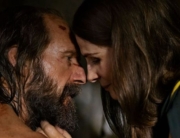It was only the third day of the Cannes Film Festival when Chicago Tribune critic Michael Phillips rightfully predicted that the first feature film by Hungarian director Laszlo Nemes would win a top jury award. He wasn’t exactly sticking his neck out. Even if the official competition’s lineup were strong this year, and it wasn’t particularly, Son of Saul would have stood out for the maturity and assuredness of its filmmaking. Besides Todd Haynes’s Carol, Saul was the contender bound to win something, according to the general goodwill on the Croisette. As it turned out, Nemes, a former assistant director to Béla Tarr, won the Grand Prix, considered the second most prestigious prize after the Palme d’Or.
The film takes place entirely in the Auschwitz-Birkenau death camp and is told from the point of view of a prisoner. Nemes takes the road less traveled, given the subject matter, by refraining from exploiting the inherent violence for a facile visceral effect. Nor does his film overstate the obvious, which is why it may also strike some as cold and underwhelming. (It’s difficult to locate a cathartic moment.) Though harsh and understated, Nemes’s unflinching film gains power by refusing to grant relief; death and horror are always in the background.
In the first moments, the term sondekommando is defined on screen as “a bearer of secrets,” referring to those (mostly Jews) who have been given a temporary reprieve from death and forced to work in the camps. Immediately, the smooth, handheld camera tracks a man in his mid-thirties: Saul (Geza Rohrig). Haggard, ashen, and with heavy bags under his eyes, he could be anywhere from 40 to 55. He wears a faded olive green suit jacket, with a large red “X” on his back, the sign of his position.
In keeping with the detached tone, Saul remains guarded, moving forward, keeping his head down, and looking straight ahead. While the man’s myopic vision is mental, viewers also have blinders on. The old-school aspect screen ratio of 1.37, postage stamp–size compared to widescreen, excludes much of what is happening in the background and off to the sides. The soundtrack, though, is feverish, a cacophony of slamming doors, a barrage of languages, and muffled screams.
Day into night, Saul removes bodies out of the gas chamber and carts them to the crematorium. Clothes left behind will be methodically picked over by him and other sondekommandos—the found items used for barter and bribery. As Saul scrubs the shower floor, he hears the dying gasps coming of a young boy. From here on out, Saul’s actions center on the dead youth as he sets out to give the boy as proper a burial as he can cobble together. His first hurdle: to hide the body so that it won’t be cut open in an autopsy. Second, to find a rabbi.
The film relies more on action and little in the way of exposition to depict the strata within the camp and its industrialized operations. Because so little is known about Saul, he remains a blank slate upon which the audience projects a history; there are no clunky flashbacks or direct references to life before internment. Throughout, the film emphatically portrays Saul and his cohorts as victims forced into labor and not as collaborators.
While there’s not much in the way of plot manipulation and no musical score to work over the emotions, no one could mistake this for as a literal representation of the Holocaust, though it is historically sound. The high volume of cargo trains arriving with more Jews suggests the time is the fall of 1944, when the numbers of deaths increased as the Third Reich’s hold in Eastern Europe decreased (though the film was clearly filmed during a richly verdant summer). This is a work of fiction, with a sparse, urgent storyline and a subplot involving subterfuge: Saul takes part in a plot to retrieve a package of explosives from a female inmate at a munitions faction, a plan inspired by the actual October 7, 1944, uprising at Auschwitz, where a unit of sonderkommandos was largely made up of Hungarian Jews.
Through fictional circumstances, Nemes delineates his main theme in excruciating detail, the individual’s need vs. the community’s, by raising the question of whether Saul’s responsibility lies in fulfilling his personal quest or in fulfilling his duty to his fellow prisoners. To paraphrase one of his coconspirators, will he fail the living for the dead?
With an emphasis on psychological nuance rather than on shock and revulsion, Son of Saul doesn’t challenge or counter the heroic Schindler’s List. Both films stand out for their distinctive standpoints. To say that the newer film contradicts the tenderness of Life Is Beautiful is an understatement. (The latter film could be from another planet.) It’s most like, and shares similar incidents with, Tim Blake Nelson’s merciless The Grey Zone (2001). More a docudrama, it offers a wider view of the day-to-day atrocities at Auschwitz. It makes graphic what Saul infers and is a better film than its reviews imply, despite the didactic dialogue and the thick German accents. Nemes’s film, on the other hand, shows rather than tells, and not one directorial choice feels rigidly imposed.
Son of Saul, this year’s Oscar submission from Hungary, will be released in the States this December.







Leave A Comment